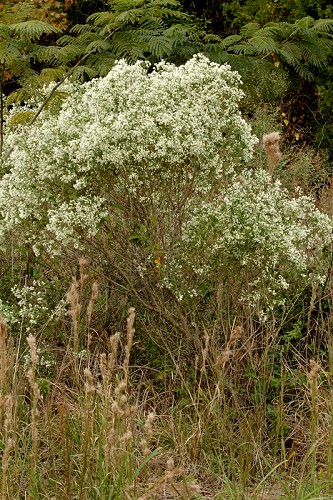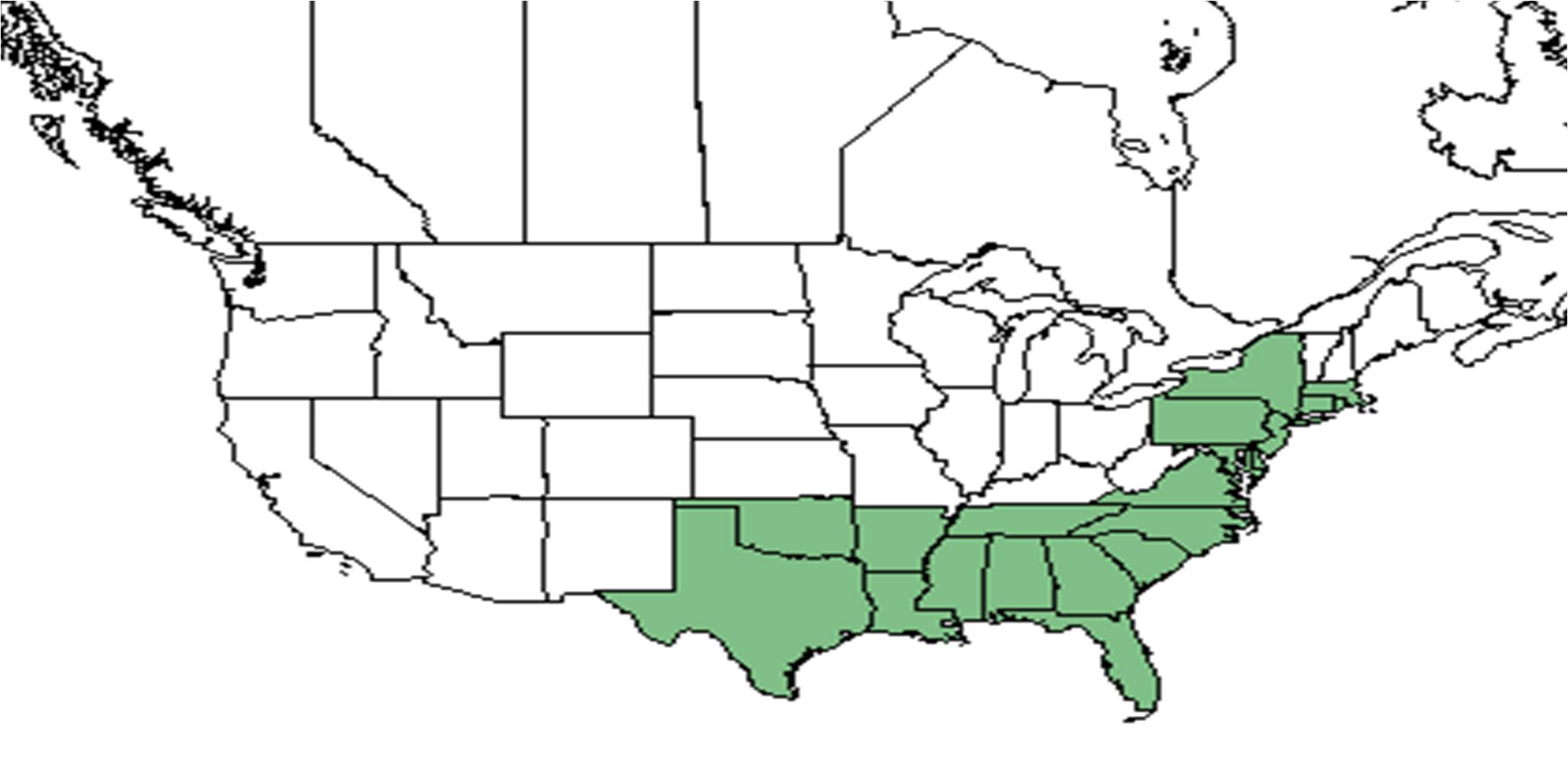Difference between revisions of "Baccharis halimifolia"
(→Ecology) |
|||
| Line 58: | Line 58: | ||
===Use by animals===<!--Herbivory, granivory, insect hosting, etc.--> | ===Use by animals===<!--Herbivory, granivory, insect hosting, etc.--> | ||
| − | While the leaves on this plant are poisonous to livestock, marsh wrens and small birds use the openly branched and brittle stems for nests.<ref name= "Miller>Miller, Christopher. (2006). Plant Fact Sheet: Eastern Baccharis Baccharis halimifolia. N.R.C.S. United States Department of Agriculture. Somerset, NJ.</ref> | + | While the leaves on this plant are poisonous to livestock, marsh wrens and small birds use the openly branched and brittle stems for nests. The baccharis foliage feeding beetle (''Trirhabda baccharidis'') is a well known beetle to help keep Baccharis populations in check.<ref name= "Miller>Miller, Christopher. (2006). Plant Fact Sheet: Eastern Baccharis Baccharis halimifolia. N.R.C.S. United States Department of Agriculture. Somerset, NJ.</ref> |
<!--===Diseases and parasites===--> | <!--===Diseases and parasites===--> | ||
Revision as of 17:57, 26 March 2019
| Baccharis halimifolia | |
|---|---|

| |
| Photo by John R. Gwaltney, Southeastern Flora.com | |
| Scientific classification | |
| Kingdom: | Plantae |
| Division: | Magnoliophyta - Flowering plants |
| Class: | Magnoliopsida - Dicotyledons |
| Order: | Asterales |
| Family: | Asteraceae ⁄ Compositae |
| Genus: | Baccharis |
| Species: | B. halimifolia |
| Binomial name | |
| Baccharis halimifolia L. | |

| |
| Natural range of Baccharis halimifolia from USDA NRCS Plants Database. | |
Common names: Eastern Baccharis; Silverling; High-tide Bush; Mullet Bush; Groundsel Tree
Contents
Taxonomic notes
Synonym: Baccharis halimifolia var. angustior de Candolle The Flora of North America.
Description
A description of Baccharis halimifolia is provided in The Flora of North America.
Baccharis genus are dioecious, glabrous shrubs. They are rarely small trees. The leaves are alternate, fleshy, toothed or entire. The heads pedunculated or sessile, most of the time in 3-5 glomerules. The involucres are cylindric, 4-5 mm long, 2.5-3.5 mm broad. The bracts are imbricate, sometimes purplish in color, and obtuse. The flowers are discoid and yellowish in color. The nutlets are tan in color, lustrous, cylindric, 10-ribbed, glabrous, and 1.2-1.5 mm long. The pappus bristles are white to tan in color. The capillary is 7-10 mm long.[1] Specifically for B. halimifolia, is a shrub, growing to approximately 1-4 m tall. The leaves are elliptic to obovate, rarely ovate; are coarsely serrate but mostly towards the apex, rarely entire. The leaves grow 3-7 cm long and 1-4 cm wide. The petioles are 5-12 mm long. The involucres are mostly in pedunculated glomerules. [1]
Distribution
Ecology
Phenology
B. halimifolia has been observed to flower in February and between September to December.[2]
Seed dispersal
This species is thought to be dispersed by wind. [3]
Pollination
The following Hymenoptera families and species were observed visiting flowers of Baccharis halimifolia' at Archbold Biological Station. [4]
Apidae: Apis mellifera
Apidae: Bombus impatiens
Colletidae: Colletes mandibularis, C. simulans, C. thysanellae
Halictidae: Agapostemon splendens, Augochlora pura, Augochlorella aurata, Augochloropsis metallica, Halictus poeyi, Lasioglossum miniatulus, L. nymphalis, L. puteulanum, Sphecodes heraclei
Leucospidae: Leucospis affinis
Leucospididae: Leucospis affinis, L. robertsoni, L. slossonae
Pompilidae: Anoplius atramentaius, A. parsoni, Episyron conterminus posterus, Poecilopompilus algidus, P. interruptus
Sphecidae: Bicyrtes quadrifasciata, Cerceris blakei, C. flavofasciata floridensis, C. tolteca, Ectemnius decemmaculatus tequesta, E. rufipes ais, Larra bicolor, Oxybelus decorosum, O. laetus fulvipes, Palmodes dimidiatus, Philanthus ventilabris, Tachytes distinctus, T. floridanus, T. pepticus, T. validus
Vespidae: Pachodynerus erynnis, Parancistrocerus salcularis rufulus, Polistes bellicosus, P. dorsalis hunteri, P. fuscatus, P. metricus, P. perplexus, Stenodynerus beameri, S. fundatiformis, S. lineatifrons, Vespula squamosa, Zethus slossonae, Zethus spinipes
Use by animals
While the leaves on this plant are poisonous to livestock, marsh wrens and small birds use the openly branched and brittle stems for nests. The baccharis foliage feeding beetle (Trirhabda baccharidis) is a well known beetle to help keep Baccharis populations in check.[5]
Conservation and management
Cultivation and restoration
Photo Gallery
References and notes
- ↑ 1.0 1.1 Radford, Albert E., Harry E. Ahles, and C. Ritchie Bell. Manual of the Vascular Flora of the Carolinas. 1964, 1968. The University of North Carolina Press. 635-6. Print
- ↑ Nelson, G. PanFlora: Plant data for the eastern United States with emphasis on the Southeastern Coastal Plains, Florida, and the Florida Panhandle. www.gilnelson.com/PanFlora/ Accessed: 7 DEC 2016
- ↑ Kirkman, L. Katherine. Unpublished database of seed dispersal mode of plants found in Coastal Plain longleaf pine-grasslands of the Jones Ecological Research Center, Georgia.
- ↑ Deyrup, M.A. 2015. Database of observations of Hymenoptera visitations to flowers of plants on Archbold Biological Station, Florida, USA.
- ↑ Miller, Christopher. (2006). Plant Fact Sheet: Eastern Baccharis Baccharis halimifolia. N.R.C.S. United States Department of Agriculture. Somerset, NJ.